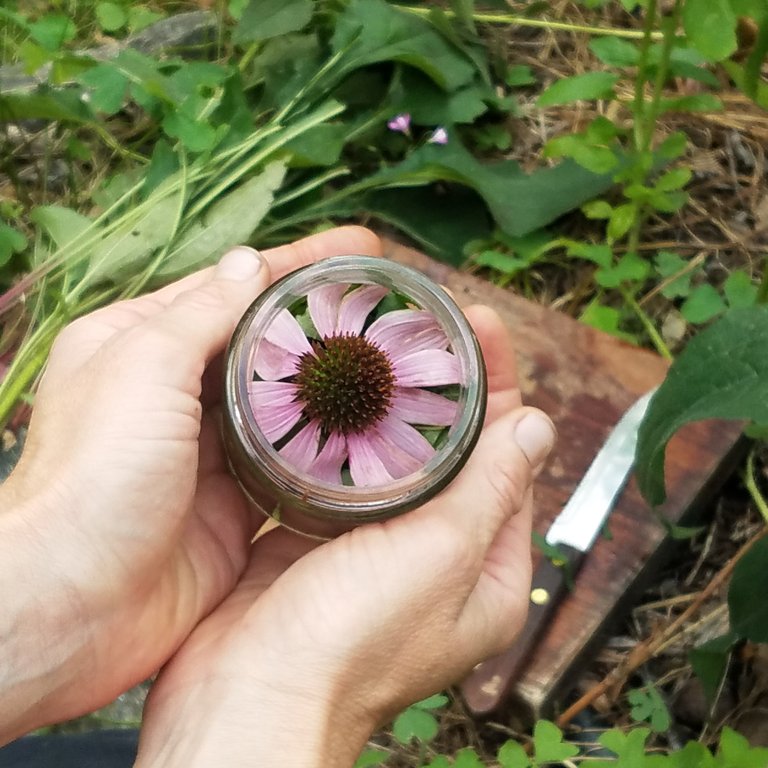On the plains of North America the purple cone flower has been used for snake bites, as well as to ward of fevers and cure slow healing wounds. The eclectic herbalists of the 19th century saw the local people curing with echinacea and adopted the herb into their medicine chest. That is when Echinacea began to gain fame for healing and in the last few decades has become an integral part of western herbalism.

Due to the increase in popularity Echinacea is no longer as plentiful in its native landscape though more and more herbalists are growing this herb in gardens all over the planet. I am one such herbalists who dedicates time and space to growing echinacea which I consider and essential part of my herbalism practice.

The seeds of these plants come from a nursery I used to help out at in Northern California. The nursery was located at the very edge of a university town where agricultural fields met suburbia. There my gardener friend and mentor grew native plants and hard to find herbs of all kinds. A few of their seeds I brought with me to my garden in the mountains of Argentina.
In this row there are several plants that are between three and four years old and ready for harvesting. This is the great benefit of growing you own echinacea, their medicine is most potent after three years of growth.

A close friend of mine is going through a major health challenge and needs the antiviral and immune system supporting medicine that is contained in the entire plant. But, of course, the most contentrated medicine is stored in the roots so I took a bit of time yesterday to harvest one plant to make a potent tincture for her. Fall is the best time to harvest the roots in general. I pulled one plant out by hand and rinsed off the soil in a bowl of clean spring water.

I do most of my medicine making outside and yesterday decided to bring my supplies to the garden. All I needed was a cutting board, knife, and sterilized jar to hold the herbal ingredients. I started out by chopping up the freshly cleaned roots.

Alongside the roots I also added a few chopped leaves as I have read from several sources that the leaves also contain immune system supporting components. The leaves add a very spicy flavor to the tincture, something like oregano with a bit of chili pepper, so I will give my friend a warning of the extra kick before she tries the tincture.

Then I added a single flower to the small jar and poured over the grain alcohol. This tincture will sit for four to six weeks before separating the plant material and pouring the alcohol into dropper bottles for daily use. In general it is best to take echinacea for two weeks, then rest for two weeks, before beginging the cycle again.
Echinacea has a whole list of herbal actions from immune sytem support, to antiviral, and has even been recomended as a first response for rattle snake bites. I have found even small doses to be a very effective treatment to long term respiratory issues, such as a persistant cough, and a great preventative medicine to avoid illness during the colder months.

In this case there is more than just physical medicine going on here. These plants hold in their roots, leaves, and flowers a whole history of healing. The seeds hail from my homeland, their ancestors have healed my ancestors and the native people of North America for centuries. It is a very significant legacy and I feel honored to be able to share their medicine so far away from where this lineage began.
What a beautiful, mindful, complete practice herbalism is. And darling echinacea does it so prettily. Gorgeous post and a remind to try to go echinacea AGAIN next year... I never have success.
I wish you luck with your future Echinacea plants!! There are so many herbs and crops that others say are so easy to grow but never seem to work out for me, still I want to give a couple of them a go again when I move about a mile away in a year or so.
Something that helped me grow these lush echinacea plants is treating them like a crop rather than an herb. In years past I grew them in a herb spiral with rosemary and thyme that was only watered about once a week. That worked out well during the rainier years but the past two years they have done so much better in a garden bed growing alongside basil, flowers, and tomatoes.
Ah that's interesting - I will try that when I get home.
Such dedication and care towards plants is rare in itself. Before this I did not know anything about this plant and now after reading your blog it seems that I know everything. Thank you for writing such an informative blog!

Yay! I am so happy that this post informed you. Hopefully one day you can try growing echinacea yourself.
I surely will.. I still have many plants btw but most of them are vegetables and flowers. 😊
Congratulations @calendulacraft! You have completed the following achievement on the Hive blockchain And have been rewarded with New badge(s)
Your next target is to reach 4000 upvotes.
Your next target is to reach 800 comments.
You can view your badges on your board and compare yourself to others in the Ranking
If you no longer want to receive notifications, reply to this comment with the word
STOPCheck out our last posts: